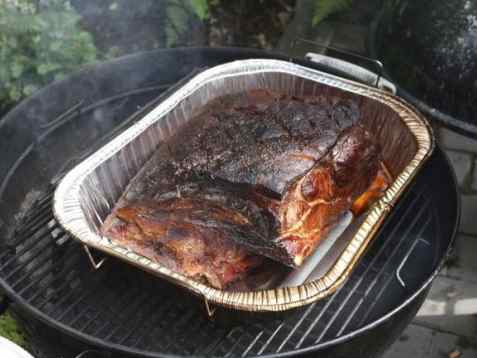
Woods: Start by soaking wood chunks in water for at least one hour; chips (including wine barrel chips) and aromatic twigs (grape vines or fruit wood twigs) need only 30 minutes of soaking. Shake all excess water off woods before adding them to your fire or smoker box. You can find smoking woods in hardware stores and home centers-or if you're lucky, in your own backyard! Wine barrel chips are available in specialty food stores and gift shops, and some hardware stores.

Water: Water adds moisture to the smoking process so meats come out flavorful and tender. If you're using a traditional smoker with a water pan, try adding barbecue sauce, marinades, wine, beer, fruit juices, or herbs and spices to the water pan for additional flavor. Be sure to keep the water pan full. For large roasts and turkeys, you may have to add water to the pan a couple of times throughout grilling. Check the water pan when you add charcoal-a watering can makes replenishing easy. (Note: When smoking cheese, add ice to the water pan so the cheese doesn't melt above it.) You can use a water pan with charcoal and gas grills, too.
Food: Place food in the center of the cooking grate above the water pan (if you are using one). Remember that smoke and heat escape every time you peek into the grill, so add 15 minutes to cooking time for each peek (more if you are smoking in cold weather). Boneless meats, such as beef brisket and pork shoulder, will shrink considerably during smoke-cooking, unless they have a heavy layering of fat. Simply cut off the fat before serving. (Note: Consider cooking your meFood: Place food in the center of the cooking grate above the water pan (if you are using one). Remember that smoke and heat escape every time you peek into the grill, so add 15 minutes to cooking time for each peek (more if you are smoking in cold weather). Boneless meats, such as beef brisket and pork shoulder, will shrink considerably during smoke-cooking, unless they have a heavy layering of fat. Simply cut off the fat before serving. (Note: Consider cooking your menu up to two days before serving. The smoke flavor becomes richer after a day or two in the refrigerator. That's why smoked foods make great leftovers.) All Weber recipes are based on 70-degree weather with little or no wind at average altitudes, so add more cooking time for wind, cold, and high altitudes.
Preparing your Charcoal Grill, Gas Barbecue, or Traditional Smoker: Virtually all Weber Gas Barbecues can be equipped with or are sold with a smoker attachment (exceptions: Spirit Series and Genesis Junior). The smoker attachment makes it easy to turn your barbecue grill into a hot smoker. You can also improvise with a foil pan. Before preheating your grill, simply fill the water pan on the smoker attachment with hot tap water. Place presoaked wood chunks or chips/twigs in the other compartment, or in a foil pan directly on the Flavorizer Bars over the lit burner. (Use a separate pan for water if you are using a foil pan for the wood pieces.) Begin cooking after preheating and when grill is fully smoking. You can get a smoker attachment for your grill by visiting your local dealer, or calling Weber Customer Service at 1-800-446-1071. Please have your grill model number available.
Smoker: Always position smoker on a level, heatproof surface away from buildings and out of traffic patterns. It's best to find a place away from the house, since smoke aromas can linger for hours.
Weber Chef's Tips for Beginners
• Use a meat thermometer to make sure smoke-cooked foods are done but not overcooked. Smoke-cooked foods look different than other grilled or oven-prepared foods. They may be pink or red when completely cooked (apple wood especially will make chicken look red, for example).
• Use tongs and barbecue mitts to add charcoal, turn meats, refill the water pan, or adjust vents.
• Do not use charcoal infused with starter fluid-it can add an unpleasant taste to your smoked foods.
• Experiment with different woods and meats until you find the right combination for your tastes.
• Start with a small amount of wood to see how you like the flavor, then add more for more intense smoky taste. (Just don't overdo it; too much wood smoke over long periods can make food taste bitter.)
• Try combining woods as you get more experienced for unique and flavorful results.
• Keep a smoker's notebook while experimenting. Jot down ingredients, wood amounts and combinations, and results so you can repeat successes. (Unless, of course, you want to keep your best recipes a secret!)